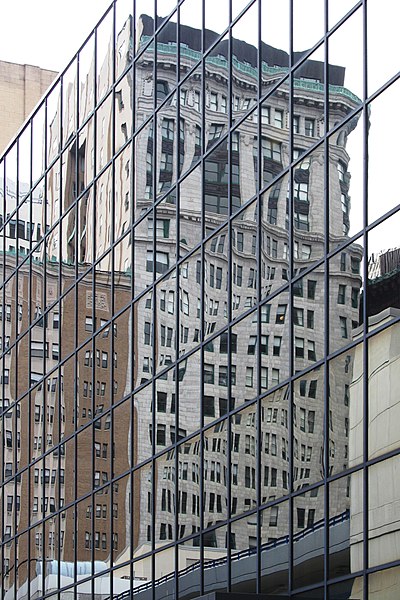
The top of the Union National Bank Building (now the Carlyle luxury apartments) reflected in the Patterson Building.

This building sits in what may be the densest block of great architecture in North America, and no one pays attention to it. It is not mentioned in the various guides to Fourth Avenue, so old Pa Pitt does not know the architect or whether the building even has a name. When the building was put up, it was apparently at 93 and 95, according to the numbers over the doors; but its address is now 311 Fourth Avenue. A classified ad in the Dispatch from 1890 mentions the firm of Black & Baird as lending money at 95 Fourth Avenue. The National Real Estate Journal in 1922 shows 311 as the home of the Freehold Real Estate Co.; if the address numbers had changed by then, this is that building.
As a work of architecture, the only thing that can be said against it is that it does not compete with the works of Daniel Burnham, Alden & Harlow, Frederick Osterling, and the other great names whose works line this street. If it is a work of one of those masters, then it is a lesser work—but certainly not one to be ashamed of. In any other block it would be one of the more distinguished buildings. The large windows on the second and third floors suggest workshops of some kind. The ornamentation is artistic and in exactly the right proportion to accent rather than unbalance the architectural forms.
Any readers who know more about the origin and history of this building are earnestly invited to comment.

In his earlier career, Frederick Osterling carved out a niche for himself providing Richardsonian Romanesque buildings for people who couldn’t get Richardson (because Richardson was dead). The Allegheny County Courthouse created a mania for the style in Pittsburgh, and Osterling seems to have had all the work he could handle. In this building from 1892, we see the hallmarks of Osterling’s own variation on the style. He was more florid than Richardson, but he was always aware of the overall composition, never allowing the numerous individual details to break up the carefully orchestrated rhythm of the façade.
Below, we see the Times Building in context, with One Oxford Centre looming in the middle distance.


“Make no little plans,” said Daniel Burnham; “they have no magic to stir men’s blood and probably themselves will not be realized.” The Chicago Tribune tells us the interesting story of the long search for the original source of that quotation, and the determination that it was in fact what Burnham said. It is probably the second-most-famous quotation from an architect in history: only Louis Sullivan’s “Form follows function” has been heard more often.
Outside Chicago, Pittsburgh was where the great Burnham was most prolific. Many of our most famous buildings—the Oliver Building, Penn Station, the Frick Building, and a good number of others—are by Burnham. Most of them are colossal. But the old Union Trust Company building—now the Engineers’ Society of Western Pennsylvania—was his first work here, and it is on a small scale. Small, but rich and perfect in its way. The front is a traditional Doric temple; the treatment of the top storey behind the pediment seems to enclose the temple in its own perfect world, insulated from the ugly realities of Fourth Avenue commercialism around it. It was built in 1898, and it can be seen as an answer and a rebuke to the tasteless extravagance of Isaac Hobbs’ 1870 Dollar Bank building across the street.